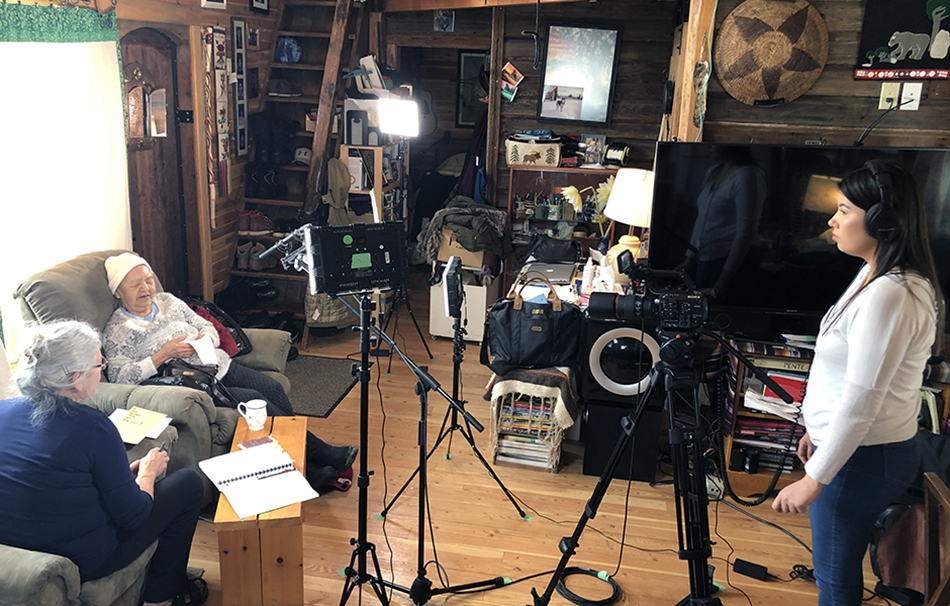Members of the Splatsin Tsm7aksaltn dictionary team record fluent speaker, Emmeline Felix. Image credit: Aaron Leon.
For half a year, Mark Turin told strangers in Nepal that he was a water well.
Wanting to respond to people’s greetings with ‘I am very well’, Turin, an associate professor in the Institute for Critical Indigenous Studies (CIS) and Anthropology, had looked up the Nepali word for ‘well’ in a dictionary and found just a one-word English translation. “For six months, I had been saying “म इनार छु” which makes no sense and essentially means ‘I am a water well.’”
This is an example of the kinds of everyday dictionary misuses and mistakes that can occur, says Turin, a Language Sciences member. Now consider if a dictionary of an Indigenous language was compiled using a colonizing language’s processes and world view. What other knowledge and important context might be omitted?
For endangered and Indigenous languages, dictionaries are valuable resources that contain understandings beyond the meaning of words, and offer insights into language structure and traditional, cultural knowledge, says Candace Galla, associate professor in CIS and the Faculty of Education.
Dictionary-making is one of many initiatives that can create capacity in Indigenous communities to document and (re)access language again in an effort to reclaim and revitalize knowledge and identity.
And given an aging population, the window of opportunity to consult with fluent speakers to create dictionaries of Indigenous languages will soon close, says Rosalind Williams, founder of the Splatsin Tsm7aksaltn (Splatsin Teaching Centre).
Relational Lexicography
Enter the Relational Lexicography project: Williams and the Splatsin Tsm7aksaltn are working with researchers at UBC to better understand how dictionaries of Indigenous and under-resourced languages are created and used by communities and scholars alike. Funded by a 2019-20 Social Sciences and Humanities Research Council Insight Development Grant, the team includes Turin, Language Sciences members Christine Schreyer (associate professor of Anthropology at UBC Okanagan), Victoria Sear (an Anthropology doctoral student), and collaborators such as Galla, and Williams’ grandson, Aaron Leon, a UBCO graduate student in Interdisciplinary Graduate Studies, himself.
“Up until now, dictionaries and their thinking have largely been framed by Western perspectives,” Leon says. The Splatsin Tsm7aksaltn has been reviewing current dictionaries with Elders to make sure that the information is relevant and correct, since there were created in collaboration with Secwepemc speakers but using Western methodologies.
Our hope is to broaden this to include more Splatsin / Secwepemc information to help round out the knowledge in the dictionary and give more context.
The field of lexicography, or dictionary compilation, can be quite traditional and conservative, says Turin. Lexicography projects for majority languages are often created in very different ways to those of under-resourced and Indigenous languages. “The tools invented by one, created by one, may not serve always the needs of the other…we’re going to look at the exciting, inspired practices coming out of more delicate, emerging partnerships in communities that are doing a huge amount with very little as these may be models for how we think about lexicography going forward.”
Online tools
The project seeks to move away from the idea of dictionaries as prescriptive documents, and instead embrace them as descriptive spaces that recognize dialectal and regional variation, and where the skills and expertise of those working with Indigenous and under-resourced languages are acknowledged and uplifted, Sear says.
As such, the team is developing a ‘relational lexicography’ framework for those making dictionaries in and for such languages. The framework will document specific needs and propose practices those working in this space might consider, including recognizing the many relationships involved in community dictionary-building, Schreyer says. The team is also developing free online tools such as a catalogue of leading North American dictionary projects of under-resourced and Indigenous languages, as well as a set of good practices.
The project will show language researchers that dictionaries can be innovative and responsive, Williams said. “They don’t always need to follow standard dictionary-making systems.”
And it’s timely, says Leon. “Having a discussion about dictionaries and what they can do and what they can’t do, to discuss how to make the process as efficient, comprehensive, critical and reflective of our Indigenous perspective as possible is critical right now as our generation of speakers and the link to that knowledge is always becoming smaller.”
If you want to learn more, access the tools and framework, or work with the Relational Lexicography team, visit https://dictionaries.arts.ubc.ca.
